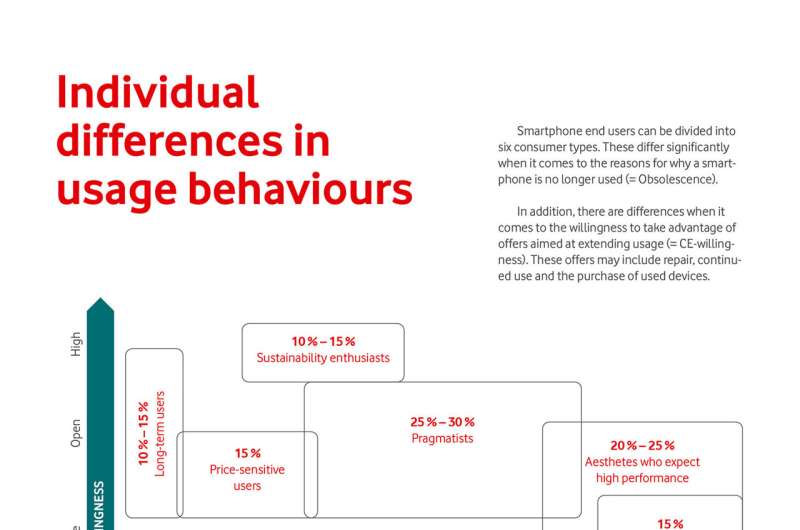
Around 20 million smartphones are sold in Germany every year, as Bitkom recently reported—a heavy burden on the environment and climate: Information and communication technologies are responsible for around 8% of Germany's CO2 emissions.
The high consumption of valuable raw materials, such as precious metals and rare earths, exacerbates the problem. A discussion paper "Circularity as the Service," published the Wuppertal Institute and commissioned by the Vodafone Institute, offers the first comprehensive overview of the entire smartphone lifecycle. It identifies strategies the smartphone industry can use to extend device lifespans and reduce their ecological footprints.
In a world in which every moment counts and connectivity is everything, smartphones have come to play an all-important role in our daily lives. In the discussion paper "Circularity as the Service," the authors identified strategies the smartphone industry can use to extend device lifespans and reduce their ecological footprints. In doing so, the potential of extending device usage spans became clear: An average usage span of five to seven years could reduce greenhouse gas emissions from smartphones by around half.
Currently, smartphones in Germany are replaced after an average of 2.5 years. Were that usage span to be lengthened, demand for new devices could be significantly reduced, which would translate into economic advantages for consumers in addition to the environmental benefits. Consumers would also prefer to use their smartphones for longer: According to a survey conducted in Austria, smartphone users would like to see device lifespans of around five years.

Dr. Julia Reinhard, Researcher in the Digital Transformation Research Unit of the Wuppertal Institute and lead author of this discussion paper, says, "It is worth taking a closer look—because the standard smartphone lifecycle has thus far primarily served the target group of tech enthusiasts and those with a distinct sense for aesthetics."
Those two groups are particularly interested in new models and the most up-to-date technology. But other target groups, like pragmatists, sustainability enthusiasts, price-sensitive users and long-term users are open to using their smartphones for longer as well as to purchasing refurbished devices.
"Current business models, however, do not sufficiently exploit these groups, which make up an estimated user share of 60%," Reinhard criticizes.
New business models are needed
The key to extending smartphone usage lies in adjusting the business model along the entire value-added chain. According to the Environmental Product Declaration of producers like Apple, around 80 percent of CO2 emissions occur during the production phase.
As such, producers should focus more on repairability and durability. This includes the design of modular smartphones that can be repaired more easily and the availability of affordable and readily available replacement parts. According to the discussion paper authors, security updates over a period of at least seven years are also crucial. Currently, however, such update periods are only four years for Android and six years for Apple devices.
Promote circularity and extend smartphone lifecycles
Economic models focused on circularity are essential for extending smartphone lifecycles. These include the expansion of repair services and increased offerings of refurbished devices by retailers and telecommunications providers.
The professional collection and recycling of devices that have reached the end of their lifecycle must also become standard, in order to recover the—according to a Bitkom estimate—210 million unused mobile devices languishing in drawers in Germany.
An appeal for a sustainable transformation
The authors of the discussion paper believe the onus is primarily on the industry and on policymakers to work towards a more sustainable use of smartphones.
Provided by Wuppertal Institut für Klima, Umwelt, Energie gGmbH
Citation: Extending smartphone lifetimes: How we can cut emissions in half (2024, June 13) retrieved 13 June 2024 from https://techxplore.com/news/2024-06-smartphone-lifetimes-emissions.html
This document is subject to copyright. Apart from any fair dealing for the purpose of private study or research, no part may be reproduced without the written permission. The content is provided for information purposes only.
